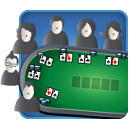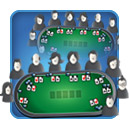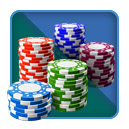Online Poker Tournaments: The Bluffers' Guide
Online poker used to be so simple for tournament players: register for a straight MTT or a quick Sit ‘n’ Go in the evening, throw a few cash tables into the mix, and away you go.
Today, however, you can spend an evening playing tournaments online and not even scratch the surface of the range and complexity of what’s on offer.
Even the humble Sit ‘n’ Go isn’t just a straightforward 10-man affair anymore: Turbos, Hyper-Turbos, 4-max, 6-max, Jackpot, the new ‘Twister’ format – if a new variation on the online tourney can be conjured up, chances are it will be.
So, to navigate the minefield of online tournaments you’re likely to encounter, here’s a rough guide. Don’t be put off by the sheer range of what’s on offer, and of course, brush up on your poker skills before committing any real money to the cause.
Note: The tournaments listed below are generally played No Limit Texas Hold’em, although Omaha, Stud and HORSE MTTs can be found online at the bigger poker rooms.
Single Table Tournaments (STTs)

Players: 6-10
Lowdown: STTs are Sit ‘n’ Gos restricted to one table. As soon as a table fills up, the game starts. Structures vary, but generally are played as Turbos (i.e. 10-minute blinds). Hyper-turbos are also popular for the multi-table grinders, with 3-5 minute blinds the norm.
Some sites offer 6-or-10 handed ‘Jackpot’ SNGs which pay out a huge jackpot for winning – or coming 2nd in - a certain number of tourneys consecutively. The jackpots are progressive, meaning a percentage of your buy-in gets pooled and paid out in the event of a winner.
Strategy: Entire books have been written about optimum online STT play (check out Collin Moshman’s excellent book, simply titled, Sit N Go Strategy) but a solid, tight-aggressive style – particularly in the turbo formats – is advisable.
Start off tight for the first few levels and play premium hands, use the continuation bet freely against weak players if you’re first to act, and once the blinds start to get high, start to re-raise all-in with 15-20bb stacks.
The aim is to get into the money places (top 3) with a healthy stack so you can put your opponents to tough decisions. Even at the low buy-ins SNG players are reluctant to call off their stacks with marginal hands and you can really profit with an aggressive strategy in the later stages. Getting into the money is fine in a Sit ‘n’ Go but 3rd place will only earn 20% of the prizepool (so doubling your money in a 10-man STT) and with 50% of the pool going to 1st place, that’s where you should always be aiming for.
Twister Sit ‘n’ Gos
Players: 3
Lowdown: If you’re a cash game player you’ll know all about the new fast-fold games which are very popular right now and take a lot of the thinking out of the game, especially the extreme formats that feature just 10bb stacks and pre-flop action only.
Well, at the major online network, iPoker, a similar ‘fast’ element is now being applied to Sit ‘n’ Gos.
Twister SNGs are 3-handed single-table tournaments where the winner takes all. A unique feature of Twister Sit ‘n’ Gos is that an extra jackpot is awarded at random to each tournament prior to the start, meaning that you could be playing for a much higher prizepool than just your buy-ins. Get lucky and you could be playing for a jackpot of 1,000x your buy-in.
Strategy: Twister SNGs are certainly fast and furious, but there’s a little more thinking involved. Think of Twisters as 10-handed SNGs and imagine you’re already in the latter stages when the first seven players have been already knocked out.
Widen your hand range from the off, as a picture card or small pocket pair will often be good against your opponents. Therefore, use position well and raise virtually everything on the Button. As it’s winner-takes-all there’s no point sitting tight, hoping for a heads-up confrontation; you need to be taking the initiative from the outset.
Heads-Up SNGs (HUSNGs)
Players: 2
Lowdown: As the name suggests, Heads-up tournaments are played one-on-one and will begin as soon as both seats are filled. Buy-ins vary wildly, but there are plenty of big-stakes games at most sites online.
The games are winner-takes-all, of course, and some regular online grinders play HUSNGs exclusively as they’re over quite quickly and easy to multi-table – perfect for getting the volume in, improving the ROI (Return on Investment) and triggering that deposit bonus much quicker.
Strategy: HUSNGs can start off slowly or be all-in-fests right from the off, depending on the players, but generally you should look to play pairs and picture cards strongly. Also, the button is vital in this game to give you an advantage, so raise virtually ANY hand when in the button to put pressure on your opponent.
Double or Nothing Sit ‘n’ Gos
Players: 10
Lowdown: Double or Nothing SNGs may not yield big profits, but played sensibly they can lead to lots of regular, small wins.
Essentially, the game stops when play becomes 5-handed and everyone gets double their buy-in. There’s no ‘1st place’, no ‘2nd place’, etc, everyone just shares the spoils.
Strategy: DONs favour tight players who are happy to sit tight and accumulate chips in good spots early on, then start to get more aggressive as play goes on. They’re like online satellites in some respects (see below) in that you don’t need to get to heads-up, or even 3-handed; just squeak in to the last five players and you cash – simple.
Multi-table Sit ‘n’ Gos

Players: 18-180
Lowdown: Multi-table Sit ‘n’ Gos exist at the larger poker sites you’ll find online in 2024. However, they aren’t scheduled events; as soon as the tables fill up, the games will start. And if you think it takes a while for 180 players to be found, think again; these large SNGs are extremely popular. Payout structures will vary from site to site, but 10 percent of the field is normal, or more.
Strategy: Multi-table SNGs usually carry a similar turbo blind structure to standard STTs, and so the same strategy applies: sit tight early on, act aggressively in late position, and play your premium hands strongly, especially post-flop.
Players will fall by the wayside quickly in a 180-man Sit ‘n’ Go, maybe much faster than you’d expect, so you will find yourself down to half the field in a short amount of time. This is the time to start applying aggressions with some strong re-raises all-in if you sense weakness.
The great thing about 180-man SNGs is that they almost play like STTs most of the time, but you have the added benefit of lots more money in the pool! Some online regulars ONLY play 180-man SNGs because of the added value.
MTT Freezeouts
Players: 12 +
Lowdown: Scheduled ‘Multi-Table Tournaments’ are simply tournaments that have more than one table at start. They kick off at a set time in the lobby regardless of how many players are sitting down. Freezeouts will feature a set amount of chips to each player. Once you run out of chips, you’re out.
Tables will be played 9 or 10-handed if playing a full-ring MTT, but specialist tournaments like 4-max or 6-max will have only 4 or 6 players respectively per table.
Many online MTTs will carry guaranteed prizepools, so it sometimes pays to hunt around for MTTs that are likely to feature ‘overlay’ (extra prize money from the guaranteed pool) and therefore offer value. Payout structures vary from site to site, but 10-20% of the field being paid out is common.
Deep Stack Tournaments
Lowdown: Deepstacks are in vogue right now – both live and online – as they afford players a lot more chips for their entry. It’s common to be given 3,000-5,000 in starting chips, but make sure you check the blind structure – if you’re playing a 5k stack but playing 10-minute blinds those extra chips won’t mean a thing.
Re-buys
Lowdown: Re-buy/Add-on (R/A) tournaments allow you to buy more chips if you run out or get below half your stack. At the end of the re-buy period (say, one hour) you can buy an ‘add-on’ for a set amount of chips. If you’re looking to play these, always budget for two re-buys plus one add-on.
Strategy: The play can often be much looser in a re-buy tournament as players have more than ‘one life’ and are therefore more willing to gamble, play a wider range of hands, and chase draws. This can be good if you’re a tight player – just wait for premium hands and play them strong. If you’re happy to budget for the extra re-buys/add-on, consider widening your range of hands (all pairs plus suited connectors and some higher connectors) and play them strongly in late position.
Re-Entry Tournaments: Re-entry tournaments have been gaining popularity in live cardrooms across the globe of late, and they are starting to appear online too.
Slightly different to re-buy tournaments, Re-Entry games allow players to re-enter the same tournament at a later stage, often on a different day if it’s a multi-day tourney. You’ll have to pay the tournament fees again, of course, but think of them as another chance if things don’t go your way.
Double/Triple Chance Tournament

Lowdown: Also popular in live events, Double and Triple Chance tournaments allow you to add a second starting stack to your own at any point in the tournament (or a second AND third in Triple Chance).
Some players like to take the extra stack straight away and utilize the bigger stack early on, or wait and use it as a ‘last chance’ if things go awry.
Fast-Fold Tournaments
Lowdown: Fast-fold has been the buzzword of online poker over the past couple of years, and virtually every network has its own version of fast-fold poker cash games.
Fast-fold basically re-seats you at a different table as soon as you fold your hand, so there’s no waiting around for your hand to end; it’s straight onto the next group of players. Plus, online it means it’s much harder for your opponents to take notes on you.
Some sites are now adapting the format to tournaments. When you join a fast-fold poker tournament, you’ll be part of a large player pool and – like cash games – face a completely different set of players after you fold a hand.
Fast-fold really comes into its own in tournaments because of the wildly varying chip stacks that will occur during a game (often unlike many cash games): just when you’re glad to be on a table of short stacks playing as the chip leader you fold and get transported to a table with 8 fellow big stacks.
Fast-fold tournaments revert to a ‘normal’ tournament structure when it reaches the final table.
Bounty Tournament
Players: 9+
Lowdown: As the name implies, every player in the game has a ‘bounty’ on their heads (in this case, a portion of your buy-in) which can be won by simply knocking a player out. The more players you knock out the more bounties you win – simple.
Freerolls
Players: 9+
Lowdown: Most poker sites feature daily or weekly freerolls to give new players the chance to win cash. They are free to enter or you can use FPPs (Frequent Player Points) to ‘buy’ your way in.
Some poker magazines even carry password-protected freerolls which give away guaranteed cash or seats into major live events. They’re also good ways for online poker rooms to gain new real-money customers.
As you’d expect from a free-to-enter tournament online, freeroll players will play fast and loose, but that’s not to say they’re good places to practise a few moves and take notes on what other players are doing. Most of the time, however, they should be treated just as they are: gimmes.
Live Qualifiers / Satellites

Players: 9+
Lowdown: Have you got the $5,000 or $10,000 to buy straight into a big live poker tournament? You haven’t? Why not try out an online satellite where you can qualify for mere dollars?
Think of satellites as multi-levelled Sit ‘n’ Gos with the winners going through to the next round. When you get to the satellite final you’ll have got there having spent just a few dollars (or less if you used Player Points) and often sites will guarantee a package or two as prizes in the online qualifying final. These will normally include a live tournament buy-in plus travel costs and spending money.
Strategy: Let’s say you’re playing a major online satellite final and there are 5 prize packages up for grabs. The key thing you need to remember is, like Double or Nothing tournaments, you don’t NEED to win the tournament, just get to the money places. Therefore, make sure you accumulate chips early on, be aggressive with your post-flop play, and hang on to your chip advantage. This will make the bubble play (when you get down to 7 or 6 players) much easier for you.
Sitemap | About & Contact | Disclaimer | Privacy

PokerSites.com is the only dedicated review site selected as a member of the Interactive Gaming Council.
